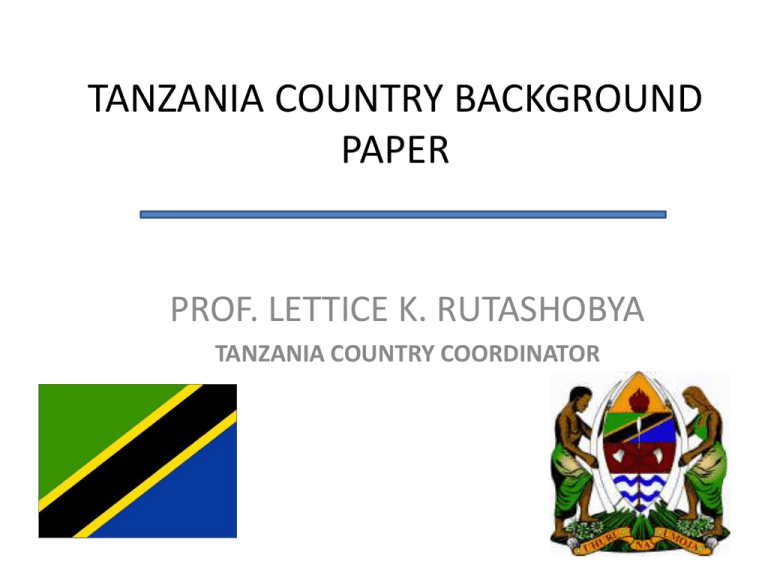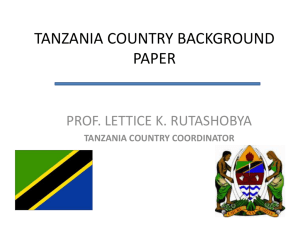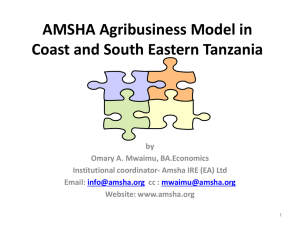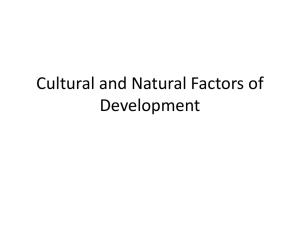Tanzania Country Background Paper Presentation
advertisement

TANZANIA COUNTRY BACKGROUND PAPER PROF. LETTICE K. RUTASHOBYA TANZANIA COUNTRY COORDINATOR SAFIC Tanzania Team • • • • • Lettice Rutashobya Marcellina Chijoriga Goodluck Charles David Rwehikiza-PhD candidate Japhet Mbura-PhD candidate OUTLINE • • • • • Introduction Macro-economic Situation Economic Transition Research questions Sector focus – Agribusiness – Tourism • Conclusions and implications for further research Introduction • There is a broad consensus emerging that improving the investment climate in Africa is the best way to spur industrialization, technological development, sustained poverty reduction and improvement in the general standard of living. • The argument that Africa’s business environment needs some improvement has therefore gained increasing currency. Introduction • However, in the face of such overriding concerns about unfavourable business environment and several business challenges in Africa and Tanzania in particular, recent studies (e.g. Willem te Velde, 2010; Charles, 2009) indicate that some firms are able to break through and become successful. • In the presence of findings that show that African firms are becoming successful in the often challenging environment in the continent, empirical data on performance drivers of African firms are scarce and do not adequately address or explain the dynamic relation between the contingencies, the strategies and the performance of the firms (Jorem et, al., 2012). Introduction • Our current study on successful African firms and institutional change attempts to address these gaps in the existing literature. • The research issues are in line with the key strategic management concerns that attempts to explain the issue of firm success and determinants of performance difference among firms. • Theoretically, we situate our research in two broad debates: Theories of the firm and institutional perspectives. Introduction • Even as the theoretical debate on the firm performance is advancing and empirical studies have been conducted in various countries, the issue of differences in firm performance in different contexts is still less understood. • This is perhaps due to lack of clear understanding of the specificities of the industry and institutional contexts in which firms are embedded and their influence on firm strategy and resources dependence. • This argument is based on the view that while firm-specific factors matter in their performance, the context in which they operate needs to be understood. • Unfortunately, understanding of the contextual differences in Africa and in Tanzania in particular is limited. Macro-economic Situation Basic economic statistics (2010/2011 figures): GDP: USD 20.49 billion Real GDP Growth rate: 7 percent Total Exports: USD 2925.8 million Total Imports: USD 5834.1 million Mean Exchange Rate: TZS 1,587 per USD (September, 2012) Population Total: 45 million people Total area: 947,300 sq km of land Macro-economic Situation • Although the average growth of GDP in the last decade has been 7%, growth has not been broad-based and propoor • Export sector is factor driven (minerals &raw materialstraditional agricultural crops) • Recent move- promotion of agro-processing and agribusiness • Agricultural Growth Corridors • Agricultural Special Economic Zones Economic Transition 1961 • Freedom • Socialist economy 1967 • State owned 1980’s Currently • Structural Adjustment programme • Economic Reforms (ongoing) Business Environment • Tanzania is ranked extremely poorly by the global indices • World Bank Ranking (126-140 out of 183 countries from 2005-2012) • Global Competitiveness Report (2011/12) -113 out of 139 countries • The most problematic factors for doing business in Tanzania are identified in the Global Competitiveness Report – See the next slide ; Overall Research Question • How do successful local firms in Tanzania gain competitiveness, sustain and grow their businesses amid the changing market and institutional conditions? Specific Research Questions • What are the main internal factors that have contributed to the success of firms in the agribusiness and tourism sectors? • What are the main external factors that have contributed to the success of firms in the agribusiness and tourism sectors? • How do successful firms in agribusiness and tourism manage their relations with local and international institutions? Specific Research Questions • What are the critical moments in agribusiness and tourism firms, and how do enterprises use them to transform and grow in volatile business environments? • Are there any discernible differences in the strategies between successful local small , medium and large firms? • Are there any discernible differences in the strategies and results of firms operating locally and those crossing borders? Sector Focus • For many years the economy of Tanzania has been largely dominated by agricultural sector • However, the structure of the economy in terms of GDP composition has changed in recent years. • The share of agriculture in GDP (24.1% in 2010) has declined relative to services (43.9% in 2010) (see Figure 1). SECTORS • Other sectors that contribute significant share of GDP include manufacturing 9%, fisheries, 2% and mining 3.3%. • Recent growth has been strongly driven by the service sector and the construction and mining sub-sectors. • Even with the changing trend in the structure of the economy, agriculture remains the leading and strategic sector in terms of employment creation (75% of the population), and poverty reduction. Sectors Focus Agribusiness • Although Tanzania has been promoting agriculture in the last 50 years, development of agribusiness has not been a serious priority • However, there have currently been deliberate measures to promote agribusiness and agro-processing. Sub-sectors focus • Following the efforts done by the country to promote agribusiness, the value addition in the agro-processing sub-sector registered 55.6 percent of the whole manufacturing sector in the country in 2008 (IIDS, 2011). • Although this paper does not cover all sub-sectors, a key sub-sector involving agroprocessing considered in our current research is food processing: – – – – – – • • coffee and tea (largely owned by foreigners), edible oils (dominated by large firms which are mainly local), Dairy (local firms) fish processing (both local and foreign owned located in Mwanza and DSM), grain milling (maize,millet, wheat and soghum)-locally owned mainly located in DSM Bakeries and confectioneries (mostly small firms and local spreading across the country) Our major unit of analysis is the processors Horticulture is also considered given its growth potential (mainly foreign large firms). Tourism • The industry is thriving and is rated among the fastest growing sectors in the country taking a lead in bringing foreign exchange. • The industry accounts for 32% of total Tanzania exports . • It attracts about one million tourists per year, paying around US$ 1.1 billion. • The tourism industry is the second pillar of Tanzanian economy. • The total contribution of Travel and Tourism to GDP in 2011 is around 13 percent. • The sector contributes to more than 10 percent of the total employment. • The share of travel and tourism in GDP and its contribution to the total employment is expected to rise at least until 2021. Tourism sub sectors Hotels and restaurants • The potential of hotels and restaurants in Tanzania is huge as the volume of both internal and local visitors is increasing. • Hotels and restaurants generate a large number of indirect jobs through backward and forward linkages that can be enhanced further and realized without new major investments. • In 2009, Tanzania had 529 hotels with 32,315 rooms and 58167 beds. • A total of 641 firms are registered as hotels, rooming houses, camps and other lodging places with the Revenue Authority. • A total number of 727 firms are registered as restaurants, cafes and eating places with Tanzania Revenue Authority • While small and medium level hotels and restaurants are largely locally owned, the majority of high end hotels are foreign owned Tourism sub sectors Tour Operators • This is a sector that is a preserve of local owners by Government policy. • The sub sector is hardly hit by foreign tour agents located in the country of origin who sometimes link directly with tourist hotels, hence denying local agents some potential business opportunities. • Most of the companies are located in the Northern Circuit where most tourist attractions are found. • Out of a total of 633 firms registered with the Tanzania Tours Operators Association (TATO), 63 percent were located in Arusha, Kilimanjaro and Manyara, while 30 percent were located in Dar es Salaam, the commercial heart of the country. Key Observations and Consideration for further research • As Tanzania’s economy transforms the business environment is still volatile with a number of challenges • Owing to the importance of agribusiness, policy makers are increasingly focusing attention on agribusiness and agroindustries in their strategies to promote development. • Further, a number of weaknesses are observed in the tourism sector. • These include weak linkages between the accommodation sub-sector and other sectors such as agricultural and the manufacturing sector. Key Observations and Consideration for further research • However, our analysis shows that there are no reliable sources of data that document the profiles and performance of agricultural activities, agribusiness and tourism • Studies are needed for example to profile the entire agricultural sector and its subsectors including the value chain development. • The conceptualization of agribusiness needs further theoretical and empirical analysis to enable specific studies on how various activities are interconnected in the development of agribusiness. Key Observations and Consideration for further research • An analysis of the structure of the agribusiness sector and of the major subsectors, the dynamics of agribusiness enterprises, the exchange and trade relations in the production chain from agriculture to agro-industry, and the role of institutions important for moving agro-industry towards modernization could be interesting. • By applying institutional and network theories it would be interesting to establish how different firms are strategically interconnected in the development of the value chain. • It would be interesting to establish the overriding constraints that contribute to low growth of the sector. Thank You for Listening









